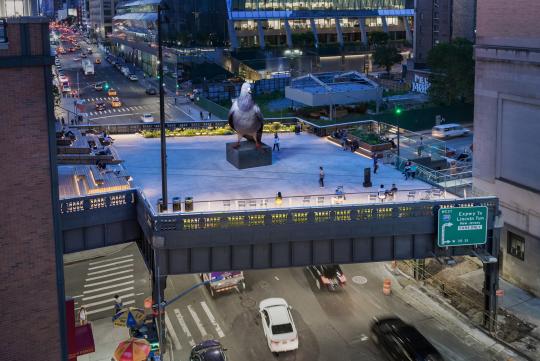The High Line knows how to placemake.
You're always happy to point to this spot, because it makes your life simple.
When someone asks, "What the hell is placemaking, anyway?" You've got an easy response:
"You know, like the High Line: from abandoned railroad line to a pleasant, interested walk, and a major tourist attraction."
Also, btw, why aren't there more "plinths" around: featuring updated sculptural art?
The script:
Take a sneak peek at this soon-to-be-famous pigeon.
It’s not only that it’s 16 feet tall.
It’s that it will be perched on a very prominent stretch of New York City’s High Line: above 10th Avenue and West 30th Street.
The artwork, by artist Ivan Argote, will be installed in October, and it’s a good bet it will be big on social media.
What’s more NYC than a pigeon? A GIANT pigeon.
Coming to a media stream near you this fall.
*Notes*
Photos: Courtesy Iván Argote / The High Line
Pigeon on plinth rendering courtesy of the artist, photo by @timothyschenck.
And, what the hell, here's the press release from The High Line:
DINOSAUR—A GIANT PIGEON SCULPTURE BY IVÁN ARGOTE— TO LAND ON THE HIGH LINE PLINTH THIS OCTOBER
The 16-Foot-Tall Iconic Bird Will Ruffle Feathers as the Next High Line Plinth Commission
New York, NY (July 31, 2024) — The High Line today announced the selection of Iván Argote’s Dinosaur, a colossal, hyper-realistic sculpture of a pigeon cast in aluminum, as the next High Line Plinth commission. The 16-foot-tall pigeon will be installed on the High Line over the intersection of 10th Avenue and 30th Streets in October 2024, and will be on view for 18 months.
To be posed on a concrete plinth that resembles the sidewalks and buildings that New York’s pigeons call home, Dinosaur reverses the typical power dynamic between bird and human, towering over the countless pedestrians and cars that will meander below its feet. The meticulously hand-painted, humorous sculpture challenges the grandeur of traditional monuments that celebrate significant historical figures, instead choosing to canonize the familiar New York City street bird.
Dinosaur was first submitted as a proposal for the High Line Plinth in 2020, among 80 proposals that included Rosenkranz’s Old Tree. During the public commenting period of the Plinth selection process, Argote’s proposal proved polarizing, receiving a great number of responses, with many New Yorkers remarking on their strong feelings of affection for or disgust of the iconic and ubiquitous urban wildlife.
Dinosaur recognizes the seemingly prosaic figure of the pigeon and celebrates its anonymity amongst the urban landscape, while also taking aim at classic monuments erected in honor of great men, who all too often are neither honorable nor great. Argote humorously suggests that, in fact, the not-tame, but no longer wild birds are likely more deserving of being placed on a pedestal and celebrated for their contributions to society than most. Further, by highlighting their origins, Argote reminds viewers that, to some degree, everyone is an immigrant. Even the pigeon, a New York fixture, initially migrated here and made the city their home, like millions of other “native” New Yorkers.
Dinosaur, like the pigeons that inspired it, bears witness to the city’s evolution, and confronts us with our ever-changing relationship with the natural world and its inhabitants. Pigeons, the oft- overlooked and derided creatures that seem to over-populate the city, first arrived in the United States via Europe, likely in the 1800s. They were used for food, kept as pets, and presented as symbols of beauty and wealth based on their plumage, but above all, they were used as reliable message carriers. Pigeons have an internal navigational mechanism — known as “homing” — that allows them to always find their way back home. This skill made the bird indispensable in war—they were used as military messengers in both World War I and World War II, saving hundreds of soldiers’ lives by transporting messages quickly to both the trenches and front lines. Many of these pigeons received gallantry awards and were celebrated as war heroes, before technology eventually rendered them obsolete.
Argote is the first Plinth artist from the global south, and the youngest yet. His work as an artist and filmmaker is heavily focused on social justice issues and historical processes, sometimes inspired by his childhood in Bogotá, as he grew up in a family with a long tradition of political and social activism, from the 1950s to the present.
Through his sculptures, installations, films, and interventions, Argote questions our intimate relationships with others, institutions, power, and belief systems. His work foregrounds tenderness and humor, through which he is able to present a critical approach to dominant historical narratives and patterns. In his interventions on monuments, large-scale installations, and performances, Argote proposes new symbolic uses of public space, and challenges our traditional and accepted ideas of whom and what we memorialize, revere, and remember.
